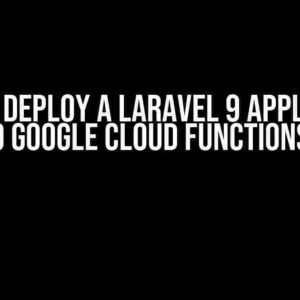GCP IAM (Identity and Access Management) is a powerful tool that helps you manage access to your Google Cloud Platform resources. With GCP IAM, you can easily manage who has access to your resources, what actions they can perform, and what resources they can access. In this article, we’ll dive into the world of GCP IAM access management, exploring its features, benefits, and best practices to help you safeguard your cloud resources.
What is GCP IAM?
GCP IAM is a fully managed service that enables you to manage access to your GCP resources. It provides a centralized platform for managing identities, permissions, and access to resources across your organization. With GCP IAM, you can create and manage users, groups, and service accounts, as well as define permissions and access controls for each.
Key Features of GCP IAM
- Identity Management: GCP IAM allows you to manage identities, including users, groups, and service accounts.
- Access Control: Define fine-grained access controls for your resources, including permissions, roles, and conditions.
- Resource Management: Manage access to your GCP resources, including projects, folders, and organizations.
- Audit Logging: Track and monitor access to your resources with detailed audit logs.
- Conditional Access: Set conditions for access to resources based on user attributes, device properties, and more.
Benefits of GCP IAM Access Management
GCP IAM access management provides numerous benefits for your organization, including:
- Enhanced Security: Centralized access management reduces the risk of security breaches and unauthorized access.
- Improved Compliance: Meet regulatory requirements with ease, using GCP IAM’s built-in compliance features.
- Increased Productivity: Simplify access management, reducing the time and effort required to manage access requests.
- Scalability: GCP IAM scales with your organization, handling large volumes of users and resources with ease.
Getting Started with GCP IAM Access Management
To get started with GCP IAM access management, follow these steps:
- Enable IAM: Enable IAM for your organization in the GCP Console.
- Create Identities: Create users, groups, and service accounts as needed.
- Define Permissions: Define permissions and access controls for each identity.
- Assign Roles: Assign roles to identities, granting access to specific resources.
- Configure Conditions: Set conditions for access to resources, using attributes, device properties, and more.
// Example IAM policy definition
{
"bindings": [
{
"role": "roles/editor",
"members": [
"user:[email protected]",
"serviceAccount:[email protected]"
]
}
]
}
GCP IAM Roles and Permissions
GCP IAM uses a role-based access control (RBAC) model, where roles define a set of permissions. Roles can be assigned to identities, granting access to specific resources.
| Role | Permissions |
|---|---|
| roles/editor | Read, write, and delete access to resources |
| roles/viewer | Read-only access to resources |
| roles/owner | Full control over resources, including management of permissions |
GCP IAM Best Practices
To get the most out of GCP IAM access management, follow these best practices:
- Use Least Privilege Access: Grant only the necessary permissions and access to resources.
- Implement Role-Based Access Control: Use roles to simplify permission management and reduce errors.
- Use Service Accounts for Automation: Use service accounts for automated tasks, reducing the risk of unauthorized access.
- Regularly Review and Update Permissions: Regularly review and update permissions to ensure they remain relevant and secure.
GCP IAM Access Management Tools and Integrations
GCP IAM provides a range of tools and integrations to simplify access management, including:
- GCP Console: Manage access to resources directly in the GCP Console.
- Cloud CLI: Use the Cloud CLI to manage access to resources from the command line.
- APIs and SDKs: Use GCP IAM APIs and SDKs to integrate access management with your applications.
- Third-Party Integrations: Integrate GCP IAM with third-party identity and access management solutions.
Conclusion
GCP IAM access management provides a powerful and flexible solution for managing access to your GCP resources. By following the steps and best practices outlined in this article, you can simplify access management, enhance security, and improve compliance. With GCP IAM, you can confidently manage access to your cloud resources, ensuring the security and integrity of your organization’s data.
Remember, GCP IAM access management is a critical component of your organization’s overall security strategy. By investing time and effort into implementing GCP IAM, you’ll reap the benefits of enhanced security, improved compliance, and increased productivity.
Further Reading
Frequently Asked Questions
Got questions about GCP IAM access management? We’ve got answers!
What is IAM in GCP and why is it important for access management?
IAM (Identity and Access Management) in GCP is a system that enables you to manage access to your GCP resources. It’s essential for access management because it allows you to control who can do what on your resources, ensuring the security and integrity of your data. With IAM, you can create and manage identities, assign roles, and set permissions to restrict access and prevent unauthorized actions.
What are the different types of IAM roles in GCP?
In GCP IAM, there are three main types of roles: Primitive roles, Predefined roles, and Custom roles. Primitive roles (Owner, Editor, Viewer) provide basic permissions, while Predefined roles offer more specific permissions for common use cases. Custom roles allow you to create tailored roles that fit your organization’s unique needs. Each role has a set of permissions that determine what actions can be performed on resources.
How does IAM conditional role binding in GCP work?
Conditional role binding in GCP IAM allows you to grant access to resources based on specific conditions, such as time of day, IP address, or user attributes. You can create custom conditions using a syntax similar to IAM policies, and then bind roles to resources with those conditions. This feature provides an additional layer of security and flexibility in access management, ensuring that access is granted only when the specified conditions are met.
Can I use IAM with other GCP services, such as Cloud Storage or Cloud SQL?
Yes, GCP IAM can be used with other GCP services to manage access and permissions. For example, you can use IAM to control access to Cloud Storage buckets, set permissions for Cloud SQL instances, or manage identities for Cloud Functions. IAM integrates with many GCP services, allowing you to consistently manage access across your resources and enforce security policies.
How can I audit and monitor IAM access in GCP?
GCP provides several tools to help you audit and monitor IAM access. You can use Cloud Audit Logs to track IAM-related events, such as role changes or permission updates. Cloud Logging and Monitoring allow you to set up custom dashboards and alerts for IAM-related activities. Additionally, you can use the IAM recommender to identify and remove unnecessary permissions, ensuring you’re following the principle of least privilege.



